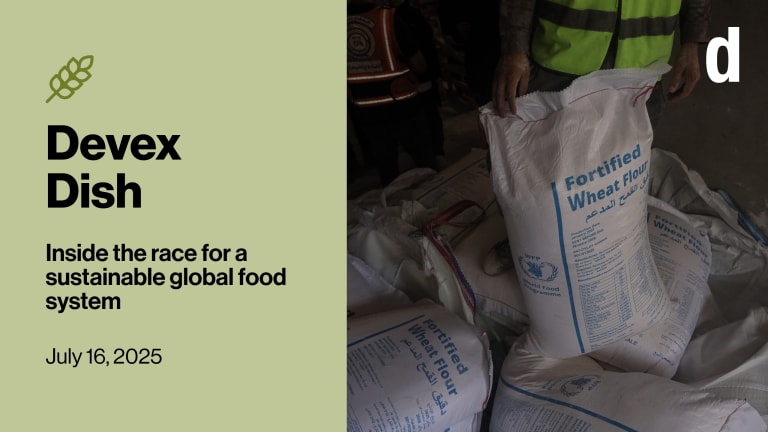
President Barack Obama’s proposed new strategy for delivering food aid envisions gradually scaling back the program that buys surplus commodities from U.S. farmers and ships them to nations in need overseas.
But will it pass Congress?
Republicans control the House of Representatives and they, as well as other lawmakers from rural states, will fight legislation that negatively affects their farming constitutents. In the past, even Democratic leaders tended to avoid bruising fights with the powerful agribusiness and shipping lobbies.
The reform would be the first major change in the way the U.S. Agency for International Development delivers food aid in three decades. Of the $1.8 billion request, $1.4 billion would go toward emergency food response, and at least 55 percent of that would be used to purchase commodities from U.S. farmers and transport them to countries in need on U.S.-flagged vessels, a likely reduction. The rest would go toward the distribution of cash coupons as well as food bought in the developing world.
The rest of the food aid budget would be used to boost the Community Development and Resilience Fund ($330 million) and to create a new Emergency Food Assistance Contingency Fund ($75 million).
Redirecting, creating new funds
The proposal’s main casualty is the Food for Peace program, which in 2012 received about $1.46 billion, according to USAID. Money for the program, which involves the buying of U.S. surplus crops and shipping them abroad, would be redirected toward international disaster and development assistance as well as the new CEFACF.
In a speech to defend the budget proposal on Wednesday, USAID Administrator Rajiv Shah insisted that the agency is not planning to end U.S. food aid.
“In fact — we’re doing the opposite. The president’s proposal commits to a more rapid, cost-effective, and life-saving food aid program that pairs the continued purchase of American food aid with a diverse set of tools, including local procurement and food vouchers,” he said.
Shah reiterated that the U.S. government commits to continue purchasing American commodities, but was now “increasing our focus on the higher value, more nutritious products that are so critical to improving child nutrition and saving lives,” and promised continued support for the shipping industry.
Aid groups elated
Shortly after the budget proposal’s release, humanitarian organizations such as Oxfam praised Obama for pushing food aid reform that, they said, would feed millions more with no additional costs to the taxpayer.
Paul O’Brien, vice president of policy and campaigns at Oxfam America, said in a statement that the proposed changes in food aid distribution would allow more flexibility and “get food to more hungry people faster, cheaper and more efficiently.”
Catherine Bertini, the former executive director of the World Food Program, explained that on the ground, the new system would cut costs “dramatically.”
Bertini added that the move would also have a positive impact on farmers in recipient countries, who would be relieved to know that the U.S. government wants to buy from them instead of shipping surplus American produce.
Improving inefficiencies in the current system by, for instance, removing restrictions on purchasing and shipping and eliminating the need to “monetize” aid were other aspects that caught the attention of humanitarian organizations.
“Experts unanimously agree that purchasing locally-produced food from farmers in or near a region facing an emergency is far more cost-effective and provides faster relief than the current approach, which requires the shipment of U.S. commodities halfway around the glob,” said an alliance of NGOs that includes CARE, ONE and Save the Children.
Changes risky, unnecesary - lobbies
On the other side of the argument, lawmakers from farm states and several industry lobbies rejected the proposed changes to the food aid scheme and warned that reducing the current program could jeopardize American business and jobs.
USA Maritime, an umbrella group of maritime companies and unions, called the proposal “misguided” and accused the Obama administration of trying to eliminate Food for Peace.
The White House “is still advocating an unnecessary and harmful change to our flagship international aid program. We continue to view this proposal as shortsighted and seriously damaging to both national security and merchant mariner jobs,” the coalition added in a statement.
ACDI/VOCA, a leading implementer of USAID agricultural projects, stressed that the current system works and local procurement is not necessarily the most effective way to deliver food to impoverished nations.
Monetization, or the sale of U.S. commodities in developing countries to fund programs, is designed to avoid market disruption, can improve the quality and quantity of food and create markets for certain crops unavailable in target countries, the group said.
Similar arguments were raised by 21 senators who in February reminded Obama in a letter that agriculture is one of the few U.S. business sectors that still produces a trade surplus, and should be supported in times of a struggling national economy.
Read more on U.S. aid reform online, and subscribe to The Development Newswire to receive top international development headlines from the world’s leading donors, news sources and opinion leaders – emailed to you FREE every business day.








